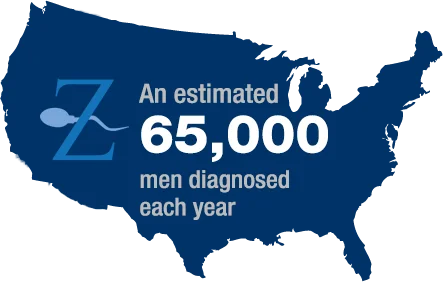Peyronie’s Disease
 What is Peyronie’s Disease?
What is Peyronie’s Disease?
Peyronie’s disease is the development of fibrous scar tissue in the erectile tissue that causes an abnormal curvature of the penis, most apparent during an erection. This can prevent a man from having sex or may make it difficult to get or maintain an erection.
Most men or people assigned male at birth (AMAB) don’t have perfectly straight erections. Just because there is a little curve in your penis, that doesn’t mean you have Peyronie’s disease. Men who’ve had a curvature their whole lives don’t have Peyronie’s disease.
In most cases, the scar forms on the top of the penis, causing it to curve upwards when it becomes erect. Your penis will bend downward if the scar is on the bottom, and sideways if the scar is on the side. In some cases, the scar develops on both the top and bottom of the shaft, which can cause the penis to become “dented” or shorter. Sometimes the scar will go all the way around the penis, making it narrow like the neck of a bottle or the center of an hourglass. About 1 in 3 men or people AMAB with this condition may have calcium in the scar tissue that can make it feel like bone.
While the cause of Peyronie’s disease is unknown, many researchers believe that the plaque of Peyronie’s disease can develop after trauma (such as hitting or bending), which causes localized bleeding inside the penis. Cases that develop over time may be genetically linked or inherited.
What are the stages of Peyronie’s disease?
Peyronie’s disease has two stages: acute and chronic.
- Acute phase: This stage lasts between six and 12 months. During this period the scar forms under the skin of your penis, causing a curvature or other change in its shape. You may feel pain when your penis is erect or when it is soft.
- Chronic phase: The scar has stopped growing in this phase, so the curvature in the penis doesn’t get worse. The pain will usually be gone by this time, but sometimes it can continue, especially with erections. Also, erectile dysfunction (ED) or problems getting or keeping the penis hard may develop.
Symptoms
Symptoms may develop slowly or appear overnight. They commonly include:
- A lump or band of hard tissue along the shaft of the penis is most noticeable when the penis is flaccid
- A bent or curved (upward or downward) appearance of the penis is noticeable when the penis is erect
- A painful erection
- Inability to maintain an erection
- Inability to achieve penetration during intercourse
- Shortening of the penis
Diagnosis
Tests to diagnose Peyronie’s disease may include:
- A physical exam. Doctors can typically diagnose Peyronie’s disease with a physical examination as the plaque can be felt when the penis is limp.
- Other tests. Ultrasound, X-rays, or other tests may be used to examine your erect penis. Ultrasound tests, which can pinpoint the location and calcification of the plaque as well as evaluate the blood flow, are the most commonly used test for penis abnormalities.
Surgery:
- Tissue Grafts. Removing or cutting the plaque and attaching a patch of skin, vein, or material made from animal organs to straighten the penis and restore some lost length.
- Nesbit Plication. A piece of the tunica albuginea from the side of the penis opposite the plaque is removed or pinched, canceling out the bending effect.
- Bent Penile Implant Surgery. A device to increase the rigidity of the penis is implanted. This can be combined with other surgical procedures to straighten the penis.
How can I prevent Peyronie’s disease?
As men and people AMAB age, their erections may be less rigid (firm), or there may be difficulty in maintaining firmness. Less rigid erections can be injured because regular thrusting during sexual intercourse may cause the penis to bend and lead to pain. To avoid this type of injury, there are a number of things you and your partner can do:
- Your healthcare provider may prescribe oral medications (Viagra®, Levitra®, Cialis®) if you have erectile dysfunction and sexual intercourse is either difficult or impossible. The first step in avoiding penile injuries is to begin to use one of these agents as soon as erections begin to become less rigid.
- You should make sure to use adequate lubrication during sexual activity. If there is not enough natural lubrication then use an over-the-counter lubricant.
- If the penis slips out during sexual intercourse, the man or his partner should use their hand to guide it back in.
- Sexual intercourse with the partner on top should be performed with caution because this position may increase the chances of the penis bending.
- Regardless of the position, the man’s thrusting movements during sexual intercourse should generally be straight in and out. He should avoid movements that might bend or twist the penis.
Many men still get Peyronie’s disease even without sexual activity. If your Peyronie’s disease is caused by genetics or a condition such as an autoimmune disorder, there was no way you could’ve prevented it.


